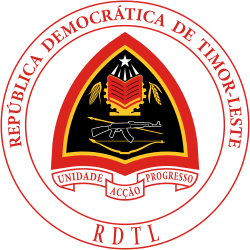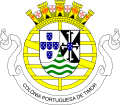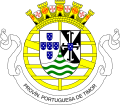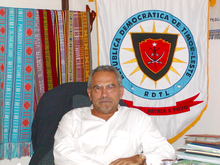
Timor is an island at the southern end of Maritime Southeast Asia, in the north of the Timor Sea. The island is divided between the sovereign states of East Timor in the eastern part and Indonesia in the western part. The Indonesian part, known as West Timor, constitutes part of the province of East Nusa Tenggara. Within West Timor lies an exclave of East Timor called Oecusse District. The island covers an area of 30,777 square kilometres. The name is a variant of timur, Malay for "east"; it is so called because it lies at the eastern end of the Lesser Sunda Islands. Mainland Australia is less than 500 km away, separated by the Timor Sea.

The national emblem of Cape Verde contains a circle within which is written the name of the nation in Portuguese. Within the circle are a torch and triangle, symbols of freedom and national unity. At the top of the shield is a plumbob, a symbol of righteousness; three chain links are at the bottom. This emblem replaces the earlier variant with the seashell that had been in use since independence. The current emblem was adopted in 1999.
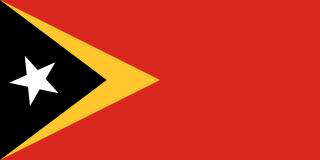
The national flag of East Timor consists of a red field with the black isosceles triangle based on the hoist-side bearing a white five-pointed star in the center superimposed on the larger yellow triangle, also based on the hoist-side, that extends to the center of the flag.
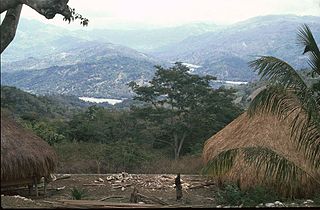
Bobonaro is a municipality in the Democratic Republic of Timor-Leste commonly known as East Timor. It is the second-most western municipality on the east half of the island. It has a population of 92,045 and an area of 1,376 km2.

The coat of arms or national emblem of Indonesia is called Garuda Pancasila in Indonesian. The main part is the Garuda with a heraldic shield on its chest and a scroll gripped by its legs. The shield's five emblems represent Pancasila, the five principles of Indonesia's national ideology. The Garuda claws gripping a white ribbon scroll inscribed with the national motto Bhinneka Tunggal Ika written in black text, which can be loosely translated as "Unity in Diversity". Garuda Pancasila was designed by Sultan Hamid II from Pontianak, supervised by Sukarno, and was adopted as the national emblem on 11 February 1950.

The National University of East Timor, is a public university in East Timor, the only one of its kind in the country.
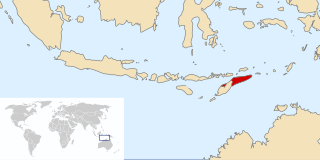
East Timor was a province of Indonesia between 1976 and 1999, during the Indonesian occupation of the country. Its territory corresponded to the previous Portuguese Timor and to the present-day independent country of East Timor.

The Armed Forces for the National Liberation of East Timor originally began as the military wing of the Fretilin party of East Timor. It was established on 20 August 1975 in response to Fretilin's political conflict with the Timorese Democratic Union (UDT).

José Maria de Vasconcelos, popularly known as Taur Matan Ruak, is an East Timorese politician who served as 8th prime minister of East Timor from 2018 to 2023. He also served as 5th president of East Timor from 2012 to 2017.

East Timorese Portuguese, or Nusantaran Portuguese, is the variety of the Portuguese language spoken in Timor-Leste. It is one of the official languages of Timor-Leste alongside Tetum. As with other Lusophone countries besides Brazil, the Portuguese language curriculum in East Timor is based on European Portuguese, with some localisations in pronunciation. East Timor is the only sovereign state in Asia with Portuguese as an official language. There is a growing demand for Portuguese-language courses in the country, both at early-learning and tertiary levels of education.

The following outline is provided as an overview of and topical guide to East Timor:

East Timor, also known as Timor-Leste, officially the Democratic Republic of Timor-Leste, is a country in Southeast Asia. It comprises the eastern half of the island of Timor, the exclave of Oecusse on the island's north-western half, and the minor islands of Atauro and Jaco. The western half of the island of Timor is administered by Indonesia. Australia is the country's southern neighbour, separated by the Timor Sea. The country's size is 14,950 square kilometres (5,770 sq mi). Dili, on the north coast of Timor, is its capital and largest city.

Suai Airport, officially Commander in Chief of FALINTIL, Kay Rala Xanana Gusmão, International Airport, and also known as Covalima Airport, is an airport serving Suai, in Cova Lima Municipality, East Timor.
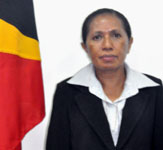
Ilda Maria da Conceição, whose resistance names were Lalo Imin and Wairaha Gae Imin, is a politician from East Timor. She is a member of the FRETILIN party.
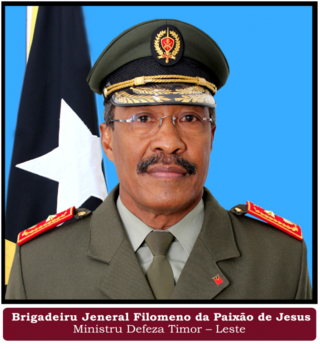
Brigadier General Filomeno da Paixão de Jesus is an East Timorese politician and former senior officer in the Timor Leste Defence Force (F-FDTL). From July 2018 to July 2023, he was Minister of Defense, serving in the VIII Constitutional Government of East Timor led by Prime Minister Taur Matan Ruak. Between October 2011 and July 2018, he was the Deputy Chief of the F-FDTL.

The old Municipal Market of Dili, now the Dili Convention Centre, is a renovated and repurposed historic Portuguese colonial-style former public market building in Dili, the capital city of East Timor.
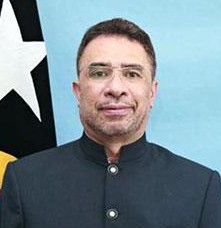
Hernâni Filomena Maria Coelho da Silva, also known by his nom de guerreNatan, is an East Timorese politician and diplomat, and a member of the Fretilin political party. He has been the East Timorese Ambassador to both Australia and South Korea. Between February 2015 and September 2017, he was Minister of Foreign Affairs and Cooperation, and from October 2017 to June 2018 he was Minister of Petroleum.

The Government Palace in Dili, the capital city of East Timor, is the official workplace of the prime minister and Constitutional Government of East Timor. In the final stages of the Portuguese colonial era, it was known as the Official Palace, and was the office of the colonial governor.

United Nations Administered East Timor refers to the period between 25 October 1999 and 20 May 2002 when East Timor was administered by the United Nations Transitional Administration in East Timor as a United Nations protectorate.

The Democratic Republic of East Timor, was a state that was unilaterally proclaimed on the territory of present-day East Timor on 28 November 1975 by Fretilin prior to the Indonesian invasion of East Timor nine days later on 7 December 1975.
